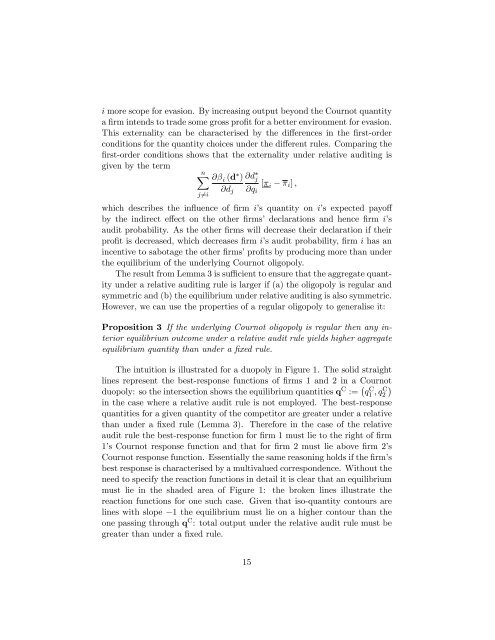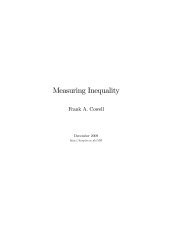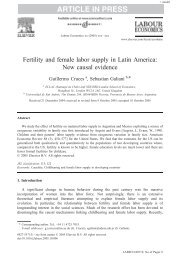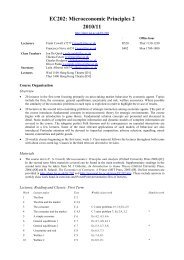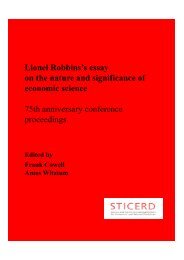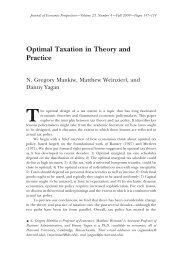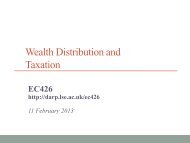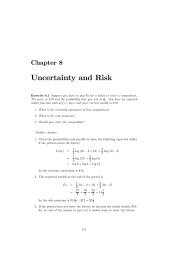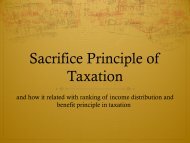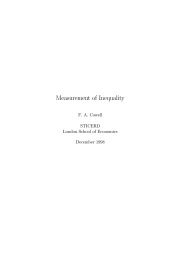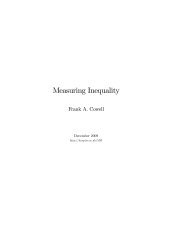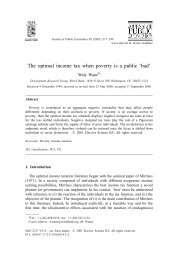Bayer, R.- C. and F. A. Cowell - DARP
Bayer, R.- C. and F. A. Cowell - DARP
Bayer, R.- C. and F. A. Cowell - DARP
Create successful ePaper yourself
Turn your PDF publications into a flip-book with our unique Google optimized e-Paper software.
i more scope for evasion. By increasing output beyond the Cournot quantitya …rm intends to trade some gross pro…t for a better environment for evasion.This externality can be characterised by the di¤erences in the …rst-orderconditions for the quantity choices under the di¤erent rules. Comparing the…rst-order conditions shows that the externality under relative auditing isgiven by the termnX @ i (d ) @d j[@d j @q i i ] ;ij6=iwhich describes the in‡uence of …rm i’s quantity on i’s expected payo¤by the indirect e¤ect on the other …rms’ declarations <strong>and</strong> hence …rm i’saudit probability. As the other …rms will decrease their declaration if theirpro…t is decreased, which decreases …rm i’s audit probability, …rm i has anincentive to sabotage the other …rms’pro…ts by producing more than underthe equilibrium of the underlying Cournot oligopoly.The result from Lemma 3 is su¢ cient to ensure that the aggregate quantityunder a relative auditing rule is larger if (a) the oligopoly is regular <strong>and</strong>symmetric <strong>and</strong> (b) the equilibrium under relative auditing is also symmetric.However, we can use the properties of a regular oligopoly to generalise it:Proposition 3 If the underlying Cournot oligopoly is regular then any interiorequilibrium outcome under a relative audit rule yields higher aggregateequilibrium quantity than under a …xed rule.The intuition is illustrated for a duopoly in Figure 1. The solid straightlines represent the best-response functions of …rms 1 <strong>and</strong> 2 in a Cournotduopoly: so the intersection shows the equilibrium quantities q C := q1 C; qC 2in the case where a relative audit rule is not employed. The best-responsequantities for a given quantity of the competitor are greater under a relativethan under a …xed rule (Lemma 3). Therefore in the case of the relativeaudit rule the best-response function for …rm 1 must lie to the right of …rm1’s Cournot response function <strong>and</strong> that for …rm 2 must lie above …rm 2’sCournot response function. Essentially the same reasoning holds if the …rm’sbest response is characterised by a multivalued correspondence. Without theneed to specify the reaction functions in detail it is clear that an equilibriummust lie in the shaded area of Figure 1: the broken lines illustrate thereaction functions for one such case. Given that iso-quantity contours arelines with slope 1 the equilibrium must lie on a higher contour than theone passing through q C : total output under the relative audit rule must begreater than under a …xed rule.15


